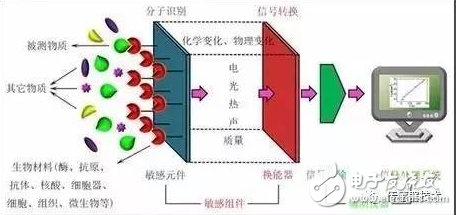A biosensor is an instrument that is sensitive to biological matter and converts its concentration into an electrical signal for detection. It is made up of immobilized bio-sensitive materials as identification elements (including enzymes, antibodies, antigens, microorganisms, cells, tissues, nucleic acids and other biologically active substances), and appropriate physical and chemical transducers (such as oxygen electrodes, photosensitive tubes, FETs, An analytical tool or system consisting of a piezoelectric crystal or the like and a signal amplifying device. Biosensors have the function of a receiver and a converter.
The biosensor consists of a molecular recognition part (sensitive element) and a conversion part (transducer):
Identifying the target to be measured by the molecular recognition part is the main functional element that can cause some physical or chemical change. The molecular recognition moiety is the basis for the selective determination of biosensors. There are mainly enzymes, antibodies, nucleic acids, DNA, cell receptors and intact cells.
Physical or chemical transducers (sensors) that convert biologically active signals into electrical signals, mainly electrochemical devices, optical devices, heat sensitive devices, acoustic wave devices, pressure sensitive devices, and the like.

Biosensor schematic
Various biosensors have the following common structures: one or several related bioactive materials (biofilms) and physical or chemical transducers (sensors) capable of converting biologically active signals into electrical signals, a combination of the two Together, modern microelectronics and automated instrumentation technology are used to reprocess biosignals to form a variety of biosensor analysis devices, instruments, and systems that can be used.
Biosensors implement the following three functions:Feeling: Biomaterials that extract the functions of animals and plants, including biological tissues, microorganisms, organelles, enzymes, antibodies, antigens, nucleic acids, DNA, etc. Mass production of biomaterials or biomaterials can be used repeatedly to reduce the difficulty and cost of testing.
Observation: Converting continuous, regular information felt by biological materials into information that people can understand.
Reaction: Display information to people through optical, piezoelectric, electrochemical, temperature, electromagnetic, etc., to provide a basis for people's decision-making.
Biosensor classificationBiosensors can be classified from these two aspects depending on the molecular recognition component and the transducer (signal converter) in the biosensor:
According to the molecular identification component:Enzyme sensors, microbial sensors, organelle sensors, tissue sensors, immunosensors.

Enzyme sensor
It is composed of an enzyme catalyst and an electrochemical device. Since enzymes are biocatalysts of protein composition, they can catalyze many biochemical reactions, and the complex metabolism of biological cells is controlled by thousands of enzymes. The enzyme is highly catalytic and highly specific, ie it selectively catalyzes the biomass (substrate) to be tested and has a chemical amplification. Therefore, the characteristics of the enzyme can be used to produce a sensor with high sensitivity and selectivity.
Microbial sensor
Microorganisms are used as molecular recognition elements. Microorganisms are more economical and durable than enzymes.
The basic principle of an immunosensor is an immune response. A biosensor that utilizes an antibody to recognize the function of antigen binding is called an immunosensor.
Biological tissue sensor
A sensor consisting of a living animal tissue cell slice as a recognition element and a corresponding transforming element.
Biological tissue sensors have the following characteristics:
1) Biological tissues are rich in enzymes. These enzymes can obtain fairly stable enzyme activities in a suitable natural environment. Many tissue sensors have a much longer working life than the corresponding enzyme sensors;
2) When the required enzyme is difficult to purify, the biological tissue can be directly used to obtain a sufficiently high enzyme activity;
3) Tissue identification components are easy to manufacture and generally do not require immobilization techniques.
Organelle electrode sensor
It is a sensor that uses animal and plant organelles as sensitive components. Organelles are tiny "organs" surrounded by envelopes present in cells, such as mitochondria, microsomes, lysosomes, hydrogen peroxides, chloroplasts, hydrogenase particles, magnetic granules, and the like.
The JUMP WELL brand embedded scan code module is small, light and easy to install. The scanning window is very large. Using CMOS imaging technology, automatic identification, sensitivity up to 100%, can easily cope with peak times. Various self-service terminal devices can be embedded. Such as supermarket cashiers, self-service vending equipment, self-service ticket checking equipment, smart door locks, etc.
Embedded image scanner, embedded barcode scanner, embedded detection scan code module
Shenzhen Geyi Technology Co., Ltd. , https://www.gy-printer.cn